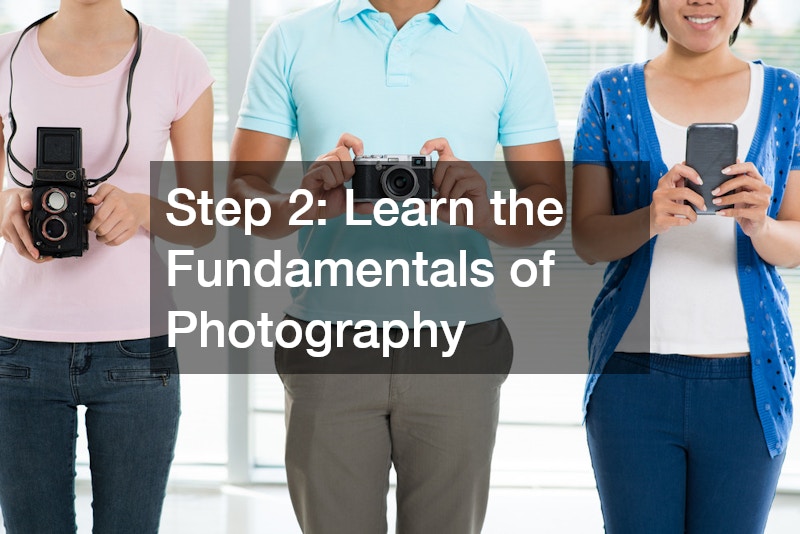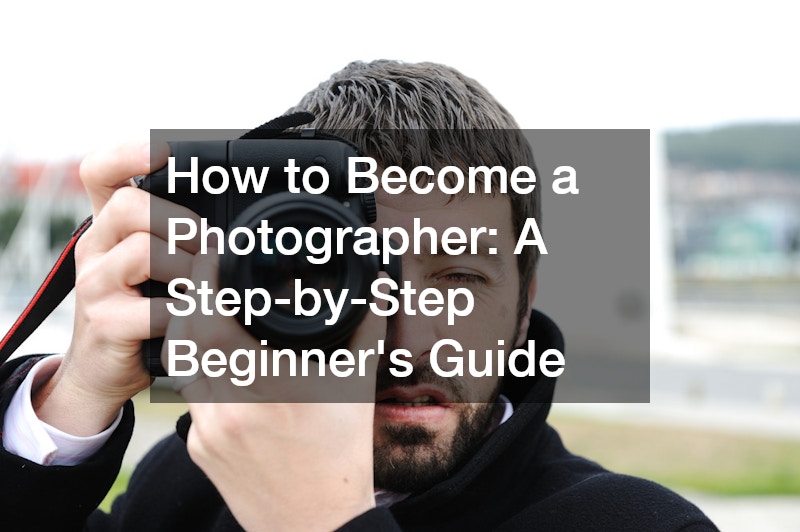In the age of digital media, photography is more than just a hobby—it’s a potential career path and a creative outlet that connects people across the globe. Whether you’re capturing portraits, landscapes, street scenes, or special moments, learning how to become a photographer opens doors to self-expression, freelance opportunities, and even full-time professions. But with so many styles, gear options, and educational resources out there, knowing where to begin can feel overwhelming.
This step-by-step guide is designed specifically for photography enthusiasts who are just starting out. From understanding the basic equipment to building a standout portfolio and marketing yourself professionally, this article will walk you through everything you need to know to start your journey as a photographer with confidence.
Step 1: Understand What Kind of Photographer You Want to Be
Before investing time and money, it’s important to define your photography goals. Ask yourself: What inspires me to pick up a camera? Your answer will help shape your learning path, gear choices, and eventual niche.
Popular Photography Genres:
- Portrait Photography: Capturing people in studio or natural settings.
- Landscape Photography: Focused on nature, scenery, and the outdoors.
- Event Photography: Includes weddings, parties, and corporate functions.
- Street Photography: Documenting everyday life and urban scenes.
- Product Photography: Ideal for eCommerce and advertising.
- Wildlife or Nature Photography: Involves travel and often specialized gear.
Understanding your passion will guide your training, influence your style, and help you find your unique voice.
Step 2: Learn the Fundamentals of Photography

Before taking great photos, you need to understand how a camera works. Many beginners start with automatic mode, but to become a skilled photographer, manual settings are your best friend.
Key Concepts to Master:
- Exposure Triangle: Aperture, shutter speed, and ISO.
- White Balance: Adjusting color temperature for accurate color.
- Composition: Rule of thirds, leading lines, framing, and symmetry.
- Lighting: Natural vs. artificial light, golden hour, softboxes, etc.
- Focus Techniques: Manual vs. autofocus, depth of field.
You can learn these skills via:
- Free YouTube tutorials (e.g., Peter McKinnon, Mango Street).
- Online platforms like Skillshare, Coursera, and Udemy.
- Local workshops or community college courses.
Tip: Practice each concept one at a time. Take multiple photos of the same subject with different settings and analyze the results.
Step 3: Choose the Right Camera and Gear
When starting out, it’s easy to fall into the trap of thinking expensive gear equals better photography. Not true. What matters most is how well you understand your camera.
Entry-Level Gear for Beginners:
- Camera Body: Consider DSLR or mirrorless models like Canon EOS Rebel, Nikon D3500, or Sony Alpha a6000.
- Lenses: A basic 18–55mm kit lens works for general shooting. Upgrade to a 50mm prime for better portraits.
- Tripod: For stability, especially in low light.
- SD Cards & Batteries: Always have extras.
- Editing Software: Adobe Lightroom and Photoshop are industry standards.
If you’re unsure about buying, consider renting gear first or purchasing secondhand from reputable sellers like B&H, Adorama, or KEH.
Step 4: Practice, Practice, Practice
The only way to improve your photography is by doing it, constantly. Set aside time every week to shoot, experiment, and evaluate your progress.
Practical Ways to Improve:
- Join a 365-day photo challenge.
- Pick a theme every week (e.g., textures, emotions, shadows).
- Collaborate with friends or models to build comfort with portrait work.
- Recreate shots from photographers you admire.
- Shoot in various lighting conditions: sunrise, midday, twilight, and indoor.
Pro Tip: Start a photography journal. Track what works, what doesn’t, and ideas for future shoots.
Step 5: Learn Post-Processing Techniques
Photography doesn’t end after you click the shutter. Editing can enhance your images, correct mistakes, and help you develop a consistent style.
Basic Editing Skills to Master:
- Cropping & Straightening
- Exposure and Color Adjustments
- Sharpening and Noise Reduction
- Spot Removal or Retouching
- Presets and Filters
Tools to Consider:
- Adobe Lightroom: Ideal for batch edits and cataloging.
- Adobe Photoshop: Best for detailed retouching and composites.
- Capture One or Luminar: Alternatives with strong RAW processing.
Advice: Don’t over-edit. Keep your images natural unless going for an artistic or surreal effect.
Step 6: Build a Photography Portfolio
Your portfolio is your calling card. It’s how potential clients or employers gauge your style, technical skills, and creativity.
How to Create a Strong Portfolio:
- Choose 15–20 of your best images, not just your favorites.
- Include a variety, but stick to your chosen niche or style.
- Organize by theme (portraits, nature, street).
- Create both a digital and physical version.
Where to Showcase It:
- Your own website using platforms like Wix, Squarespace, or Format.
- Social media (Instagram, Pinterest).
- Photography-specific platforms like Flickr, 500px, or Behance.
Consistency is key. Your portfolio should reflect a cohesive vision and tell a story.
Step 7: Start Sharing and Getting Feedback
To grow, you need to expose your work to others and accept constructive criticism. Sharing your work not only builds confidence but also helps you connect with a community.
Where to Share:
- Instagram and Facebook: Great for organic reach and feedback.
- Reddit (e.g., r/photocritique): Honest, constructive reviews.
- Online forums: PhotographyTalk, Digital Photography Review, etc.
- Photo contests: Local and online competitions can provide exposure.
Be open to feedback. It’s how you identify blind spots and refine your style.
Step 8: Understand the Business Side of Photography
If you plan to turn photography into a career or side hustle, you’ll need more than just technical skills—you’ll need business acumen.
Business Basics for Beginners:
- Set clear pricing packages and understand your market.
- Learn about copyright and client contracts.
- Invest in insurance for your gear.
- Track income and expenses using simple software (e.g., Wave, QuickBooks).
- Build an online presence through SEO-optimized blogs and keyword-rich pages.
You might also consider:
- Freelancing platforms like Fiverr or Upwork.
- Selling prints via Etsy or SmugMug.
- Licensing your photos through stock sites like Shutterstock or Adobe Stock.
Step 9: Keep Learning and Stay Inspired
Photography is constantly evolving. Trends change, new gear comes out, and your interests may shift over time. To grow, you need to stay informed and inspired.
How to Stay Sharp:
- Subscribe to magazines like Outdoor Photographer or Digital Camera World.
- Follow professional photographers on social media.
- Attend industry expos and trade shows.
- Read blogs, listen to podcasts, and join online communities.
Consider pursuing certifications or enrolling in more advanced photography courses as you progress. The more you learn, the more confident and versatile you’ll become.
What Are the Most Common Mistakes Beginners Make?
As a new photographer, making mistakes is part of the learning process—but some errors can hinder your growth if you’re not aware of them. Understanding and avoiding these common pitfalls can accelerate your progress.
Key Mistakes to Watch Out For:
- Relying Too Much on Auto Mode: It prevents you from learning manual settings, which are essential for creative control.
- Neglecting Composition: Even technically perfect photos can fail if the composition lacks impact. Learn rules like the rule of thirds and symmetry.
- Overediting: Excessive filters and retouching can ruin an otherwise great shot. Aim for natural enhancements.
- Not Backing Up Photos: Always have at least two backups of your images to avoid losing your work.
- Buying Expensive Gear Too Early: Master what you have before upgrading.
Avoiding these errors can save you time, frustration, and money as you grow into your photographic identity.
Do You Need a Photography Degree to Succeed?
One of the most common questions aspiring photographers ask is whether they need a formal education to break into the industry. The short answer is: no, but it depends on your goals.
Consider the Following:
- Self-Taught Path: Many successful photographers are self-taught, using free online resources, books, and practice.
- Formal Education: Degree programs offer structure, mentorship, and networking, which may help in specific niches like commercial or fashion photography.
- Workshops & Online Courses: These are flexible and affordable, ideal for learning targeted skills like lighting or editing.
What matters more than a degree is your portfolio, consistency, and ability to meet client needs. Experience often outweighs credentials in the photography world.
How to Find Photography Clients or Gigs as a Beginner

Once you’ve built a portfolio and sharpened your skills, the next step is finding paid opportunities. Don’t wait until you feel “perfect”—real-world experience is the best teacher.
Beginner-Friendly Ways to Land Gigs:
- Friends and Family: Offer discounted or free shoots to get testimonials and word-of-mouth referrals.
- Freelance Platforms: Use sites like Fiverr, Upwork, or Thumbtack to find entry-level gigs.
- Local Businesses: Pitch services for product shots, events, or headshots.
- Social Media: Regular posting on Instagram or Facebook with proper hashtags can draw attention.
- Model Collaborations (TFP): Trade-for-portfolio arrangements help you and models build content.
As your experience grows, increase your rates and start offering specialized packages. Always deliver excellent service to encourage repeat clients.
How Much Can Beginner Photographers Expect to Earn?
Earnings vary widely based on location, niche, skill level, and business acumen. While it might take time to become profitable, beginner photographers can absolutely earn income, even part-time.
General Earning Guidelines:
- Portrait Sessions: $50–$200 per session when starting out.
- Event Photography: $20–$50 per hour for small events; rates increase with experience.
- Stock Photography: Passive income from platforms like Shutterstock or Adobe Stock (pays per download).
- Product or Food Photography: $75–$300 per shoot, depending on complexity.
- Freelance Gigs: Project-based pricing, often negotiable.
Tip: Keep track of time, travel, editing hours, and materials when setting rates. Undervaluing your work can lead to burnout and missed opportunities.
How to Become a Photographer: Final Thoughts
Learning how to become a photographer is an exciting journey filled with creativity, challenges, and endless possibilities. While it’s easy to get overwhelmed by gear options, editing tools, or comparing yourself to professionals, remember that every expert was once a beginner.
Here’s a quick recap of the steps:
- Define your niche or photography goal.
- Learn the technical and creative fundamentals.
- Start with beginner-friendly gear.
- Practice regularly and intentionally.
- Learn to edit and enhance your images.
- Build a strong and organized portfolio.
- Share your work and seek feedback.
- Understand the business essentials.
- Keep learning and evolving.
If you stay consistent, curious, and open to feedback, photography can be not just a hobby, but a fulfilling personal or professional pursuit.
